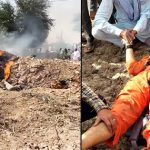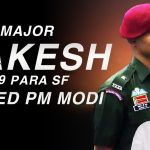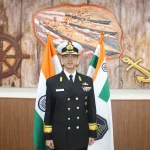“The parachute regiment”, this name can send deep shivers to the enemies, and moments of pride for the patriots. The regiment is divided into several battalions, who have proved their mettle time and time again. The regiment traces its origin back to the formation of the 50th Parachute Brigade during the British government, in the year 1941 during the Second World War under the command of Brigadier WGH Gough.
After the formation, the brigade was sent into the battle of Sangshak, where it was tasked with delaying the Japanese forces, moving up for the battle of Imphal.
What is Shatrujeet Brigade
The name ‘Shatrujeet’ given to the brigade has a special story, which is derived from a Puranic character named ‘Shatrujeet’ who could win on any enemy, the structure of this warrior looked like a person attached to a horse which signifies his power and agility in the warfare. When the brigade was formed, the structure possessed by it included :
A brigade headquarters: The headquarter was tasked with proper mobilisation of the brigade and its respective battalion, as and when required in the war. Being the newcomers to the war scenario and proving their excellence was a level apart thing which the 50th brigade headquarters proved. The headquarters had a mixed composition of the British, Indian and Gorkha forces.
A brigade signal section: The brigade signal section was all British and worked in information transfer and communication management. The signal section was commanded by Capt EJ Buirski.

151th Parachute battalion: This battalion started its service in the Internal Security of the British empire and played a major role in the Delhi riots of 1942, after which the battalion was sent to the Middle east and got its new number as 156th battalion. The battalion was destroyed in the year 1944 at Arnhem. This battalion was commanded by Lt. Col MA Lindsay.

152nd Indian Parachute Battalion: This battalion was commanded by Lt. Col BE Abbott consisted of volunteers from the 19th Indian Infantry regiments.

153rd and 154th Gorkha Parachute Battalion: This battalion was comprised of the epitomes of bravery also known as the Gurkhas. It was made of volunteers from the 9th Gurkha regiments and was commanded by Lt Col FJ Loftus-Tottenham. The 154th battalion was a direct transfer of the 3rd battalion Gurkha rifles and this battalion joined the 50th brigade around October 1943.

411th (Royal Bombay) Parachute Section IE: This was the engineers unit of the parachute brigade and was under Capt MJJ Rolt.

Pre-Independence Operations:
In the early days, the progress in training and weaponisation of the brigade was at a slower stage. The brigade also faced a shortage of planes, parachutes and glider planes in March 1942, due to which limited airborne operations could be executed.
In the year 1942, the brigade also did an operation against the Hur tribesmen who were derailing the railways, the troops were dropped in the Hyderabad-sind region from ancient Valencia bi-planes.
The brigade also performed intelligence-gathering operations in Burma.

The Battle on Sanghshak is an epitome of valour, where the soldiers from the brigade fought against two Japanese divisions and blunted their advancement. Other than these, a major airborne assault was also done against, the Japanese defensive positions on the Elephant point at the mouth of the Rangoon river. This operation was done by the Gorkha Parachute battalion on 1st May 1945. In the year 1945, the 50th para brigade was expanded to form the 44th(Indian) Airborne Divison.
Post-Independence organisations:
The 50th Parachute Brigade was made the independent brigade post-independence and had participated in numerous operations since then.
Some of the major operations conducted by this regiment include :
1. Indo-Pakistan war of 1947-48: The brigade, now the regiment proved its mettle right after the independence in the Kashmir war, where 1, 2 and 3 battalions of the brigade saw major action. Brigade commander Mohd. Usman was killed in action on July 3, 1948, and was awarded MahaVir Chakra for his valour.

2. Goa annexation of 1961: The regiment saw its second major action in the annexation of Goa, which happened in the year 1961. The regiment was sent as a support for the 17th Infantry division, and its unit was the first to reach Panjim, moving rapidly across Minefields, roadblocks and four riverine obstacles. After reaching the city, the paratroopers removed their steel helmets and donned the maroon beret, where they were seen as liberators.
3. Indo- Pakistan war of 1971: The brigade executed major operations both in the eastern and western sectors. The second battalion of the regiment was dropped at Tangail, which speeded up the liberation process of Bangladesh. The 2 paras did actions in the airborne role, followed by 7 paras as the advance guard and these were supported by the rest of the brigade in the ground role.

4. Operation Cactus: The paratroopers from the brigade actively participated in suppressing the military coup happening in the Maldives in the year 1988, the efficiency and precision were such that the operation was successful in few hours.

5. Kargil War: During the Kargil war, the battalions of the brigade were deployed in the Mushkoh valley sector, to clear intrusions from the region. The regiment also won COAS citation for exemplary performance in the region.
The current organisation in the 21st century:
In the current times, the 50th (Independent) Parachute Brigade is comprised of two parachute battalions, one special forces battalion, 60 Parachute Field Ambulance, 411 (Independent) Parachute Field Company (Bombay Sappers), 622 Parachute Composite Company ASC, 50th (Independent) Parachute Brigade OFP (Ordnance), 50th (Independent) Parachute Brigade Signal Company, 2 (Independent) Parachute Field Workshop Company, 1 parachute field regiment (Artillery) (9 & 17 parachute field regiments) and a provost section, an air defence battery. The President’s Body Guard is also part of this brigade and forms a part of the pathfinder company.

This brigade is directly under the Director General Of Military Operations and can be deployed as and when required within two hours.

The three parachute battalions in rotation form part of the parachute brigade alternatingly serving their field tenures in counter-insurgency/high altitude areas. One of the eight SF battalions too serves in the brigade on rotation. One of the two field regiments (9 Para Field Regiment and 17 Para Field Regiment, Regiment of Artillery) also forms part of the brigade while the other serves out its field tenure on rotation.













